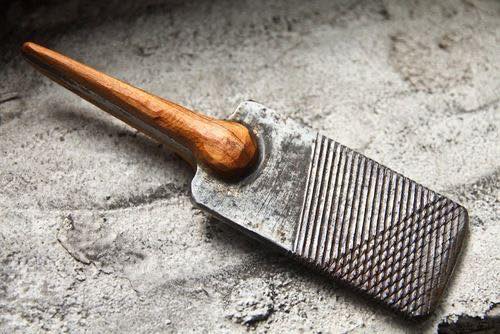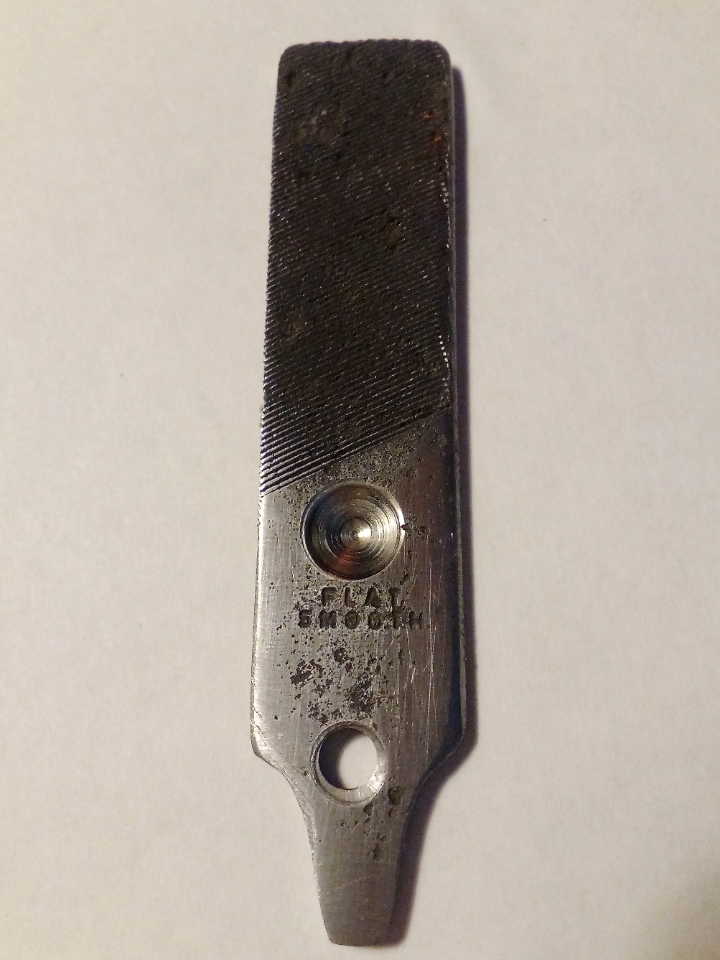A Forgotten Spark From the Past
At first glance, this little piece of metal and wood might seem like junk—something you’d toss aside without a second thought. But centuries ago, this unassuming tool could quite literally ignite life itself. Before lighters, matches, or electric sparks, people relied on a simple yet ingenious device known as the flint and steel striker to create fire.
This was not just a tool—it was survival in your pocket.
The Ingenious Design Behind the Striker
The striker, or steel striker, might look like a worn-down rasp or a broken piece of metal with a handle, but its design was deliberate. Made from high-carbon steel, the flat, textured surface was meant to strike against a sharp piece of flint stone. When the two collided, tiny fragments of steel were shaved off and ignited from the friction, creating sparks hot enough to start a flame.

The handle—often made from wood, bone, or leather—was added for safety and grip, allowing users to swing the tool with precision. Each strike required practice: too weak, and no spark; too strong, and you’d dull the steel. Those who mastered it could summon fire within seconds, even in harsh outdoor conditions.
The Science of Fire-Making
It’s simple yet brilliant. When steel hits flint, the collision produces sparks at nearly 1,500°C (2,700°F)—enough to ignite dry tinder such as char cloth or straw. People carried these items together in small leather pouches, sometimes called tinderboxes, ready to make fire wherever they went.
This method was so effective that it remained the go-to technique for hundreds of years, from medieval blacksmiths to 19th-century explorers crossing the American frontier. Every spark was a triumph—a symbol of human ingenuity over nature’s challenges.
More Than a Tool: A Symbol of Survival
In a world without electricity, fire wasn’t just warmth. It meant cooked food, light in the dark, and safety from predators. To own a striker was to hold a piece of independence. Families passed them down, soldiers carried them in battle packs, and travelers kept them close on long journeys. Losing it could mean losing the ability to make fire—and that was no small risk.
Video : How To Strike A Traditional Flint And Steel
Each striker bore the marks of its owner: the dents from countless strikes, the patina of years of use, and sometimes even initials carved into the handle. It was both a tool and a personal companion—an extension of human willpower.
From Files to Firemakers
The object you see in the picture likely began life as something else entirely—a metal file. In the past, when tools wore down, resourceful blacksmiths repurposed the hardened steel into fire strikers. The ridged texture you see wasn’t just aesthetic; it improved grip and made it easier to generate sparks.
Over time, these handmade strikers became works of art. Some were forged with ornate designs, while others stayed simple and rugged. No two were ever exactly alike.
When Fire Met Modernity
The era of the flint striker began to fade in the 19th century, with the invention of friction matches and later lighters. Suddenly, fire could be summoned with a flick of the wrist. But even as technology advanced, the old method never truly vanished.
Campers, bushcrafters, and survivalists still use flint and steel today, valuing its reliability and connection to tradition. In extreme cold or damp environments, matches can fail—but a striker and flint will always deliver, as long as there’s dry tinder to catch the spark.

A Window Into Human Ingenuity
When you hold an antique striker, you’re not just holding metal—you’re holding history. You’re touching the same kind of tool that lit fires in Viking camps, colonial hearths, and pioneer wagons. It’s a direct link to the ingenuity that powered human survival long before modern comfort existed.
It reminds us of something profound: progress isn’t about abandoning the past; it’s about building on it. The flint striker paved the way for every modern ignition device—from matchsticks to electric lighters—and it did so with nothing more than steel, stone, and skill.
The Modern Rebirth of an Ancient Craft
Today, enthusiasts and artisans still craft replicas of these strikers by hand. Some even practice primitive fire-making as a hobby or survival skill. Watching a spark catch and bloom into flame feels almost magical—a ritual connecting us to our ancestors who once depended on that very act for life itself.
Video : Fire Starting With Flint and Steel
For collectors, each striker tells its own story. The patina of age, the worn edges, and the handmade imperfections speak volumes about the people who once wielded it. They weren’t just making fire—they were shaping their world, one spark at a time.
Conclusion: The Power Hidden in Simplicity
It’s incredible how such a small, unremarkable-looking tool once carried so much importance. What looks like a scrap of metal with a wooden handle was, in truth, a lifeline. The flint and steel striker is a testament to human creativity—the art of turning simplicity into survival.
So next time you see an old object like this, take a closer look. It might not just be a relic of the past—it could be a reminder of the fire that once lit our ancestors’ way through the darkness.